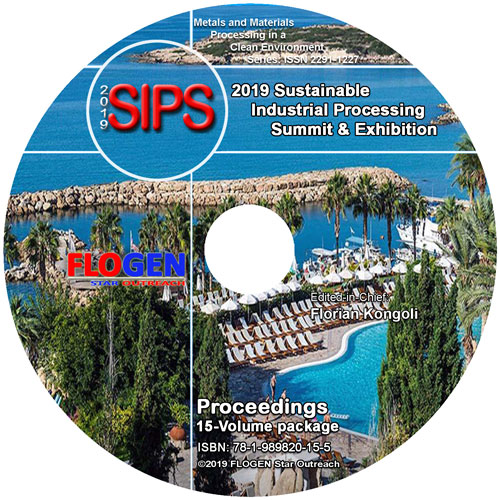2019-Sustainable Industrial Processing Summit
SIPS2019 Volume 8: Usui Intl. Symp. / Advanced Sustainable Iron and Steel Making
| Editors: | F. Kongoli, P. Assis, M.C. Gomez-Marroquin, S. Kitayama, H. Konishi, A. Murao, S. Nomura, H. Ono, H. Saxen, K. Seto, J.I. Tani |
| Publisher: | Flogen Star OUTREACH |
| Publication date: | 20 December 2019 |
| Pages: | 250 pages |
| ISBN: | 978-1-989820-07-0 |
| ISSN: | 2291-1227 (Metals and Materials Processing in a Clean Environment Series) |

CD shopping page
Antifouling activity of natural products of marine macroalgae against the Limnoperna fortunei - Golden Mussel. A review.
Camila Freitas de Araújo1; Alex Campos2; Adriano Batista3; Bernardo da Gama4; Renato Crespo Pereira5; Rodrigo Pinheiro de Almeida Santos6; Bruna Helena Malovini Loiola7; Paulo Assis8; Tateo Usui9;1FEDERAL UNIVERSITY OF OURO PRETO - UFOP/REDEMAT, Ouro Preto, Brazil; 2FEDERAL UNIVERSITY OF OURO PRETO, Ouro Branco, Brazil; 3IFMG, Ouro Preto, Brazil; 4UFF, Niterói, Brazil; 5INSTITUTO DE PESQUISAS JARDIM BOTâNICO DO RIO DE JANEIRO, Rio de Janeiro, Brazil; 6DEPARTAMENTO DE BIOLOGIA MARINHA - FLUMINENSE FEDERAL UNIVERSITY, Niterói, Brazil; 7FEDERAL UNIVERSITY OF OURO PRETO - REDEMAT, Ouro Preto, Brazil; 8UNIVERSITY OF OURO PRETO / REDEMAT, Ouro Preto, Brazil; 9OSAKA UNIVERSITY, Ibaraki, Japan;
Type of Paper: Invited
Id Paper: 365
Topic: 2
Abstract:
AUTHORS and AFFILIATION:
Camila Freitas de Araújo – Civil Engineer, Graduate Student at REDEMAT/UFOP, Ouro Preto, Brazil (camilafr.eng@gmail.com).
Alex Milton Albergaria Campos – MSc Metallurgical Engineer, Graduate Student at REDEMAT/UFOP, Ouro Preto, Brazil (alexcampos88@yahoo.com.br).
Adriano Corrêa Batista – Professor, DSc Instituto Federal de Minas Gerais, Ouro Preto, Brazil (adrianocorrea77@gmail.com).
Bernardo Antônio Perez da Gama – Professor, PhD UFF, Niterói, Brazil (bapgama@gmail.com).
Renato Crespo Pereira – Professor, DSc UFF, Niterói, Brazil (rcrespo@id.uff.br).
Rodrigo Pinheiro de Almeida Santos – Doctoral Student at UFF, Niterói, Brazil (pinheiro153@gmail.com).
Bruna Helena Malovini Loiola – Metallurgical Engineer, Graduate Student at REDEMAT/UFOP, Ouro Preto, Brazil (malovinibruna@gmail.com).
Paulo Santos Assis –Professor, PhD REDEMAT/UFOP, Ouro Preto, Brazil (assis@ufop.edu.br).
Tateo Usui – Professor emeritus, DSc Osaka University, Suita, Japan (usui@mat.eng.osaka-u.ac.jp).
Abstract
The golden mussel (Limnoperna fortunei) is a species of bivalve mollusc introduced in Brazil via ballast water in the 1990s. Given the biological and ecological characteristics of the species, as well as the favorable environment in the country for its proliferation, the golden mussel has become an exotic invasive species that has caused several problems in the aquatic environment because of its ability to form colonies in structures. The species adheres on the surfaces by protein filaments, causing serious environmental, social and economic damages, provoking structural and functional alterations in the ecosystems and damages to the human activities.
The challenge presented consists of biological fouling combat through treating underwater surfaces with freshwater natural products, in particular those from red algae. Fouling control tends to arouse the interest of shipbuilders, marine vessel operators, fish farming in tanks and hydroelectric power plants. In Brazil, the chemical treatment against the incrustation of the golden mussel, for example, made only in three hydroelectric power plants in Minas Gerais, has annual cost of R$ 1,494,000.00 [1].
With the worldwide ban of TBT-based antifouling paints since 2008, alternative, environmentally safe treatments gain more appeal, considering the risk associated with the alternative products currently in use. Natural marine products have since been recognized as a promising alternative for the replacement of commercially used antifouling until the moment [2].
A selection of natural seaweed products with antifouling activity may provide effective results with little or no environmental impact compared to currently used products [3], while contributing to the understanding of ecological functions and mechanisms of metabolic production secondary. At least 18 different regulatory biocides are currently being used as an alternative to tributyltin free antifouling paints, but these also pose some threat to the aquatic environment. In fact, even biocide-free antifouling paints are toxic to marine organisms over a broad spectrum [4]. For this reason there is still an urgent demand for new low-impact anti-fouling products.
This article aims to disseminate this broad line of research and consolidate information about the potential of marine organisms as producers of secondary metabolites (natural products) with antifouling activity, in the light of scientific production.
Key words: Golden Mussel; red algae; anti-fouling products; secondary metabolites; tributyltin.
Keywords:
Composite; Extraction; Process; Properties; Steel; Structure; Sustainability;References:
REFERENCES:[1] CEMIG. Companhia Energética de Minas Gerais. O mexilhão Dourado, uma ameaça às águas e hidrelétricas brasileiras. Ed. CEMIG, Belo Horizonte, p. 24, 2014.
[2] Bhadury, P.& Wright, P.C. (2004). Exploitation of marine algae: biogenic compounds for potential antifouling applications. Planta, v. 219, p. 561–578.
[3] DA GAMA, B. A. P. et al. The Effects of Seaweed Secondary Metabolites on Biofouling. Biofouling, v. 18, n. 1, p. 13-20, 2002.
[4] Löschau, M.&Krätke, R. (2005). Efficacy and toxicity of self-polishing biocide-free antifouling paints. Environmental Pollution, v. 138, p. 260–267.